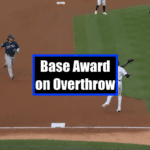5.00 Putting the Ball in Play – Live Ball
5.01 – At the time set for beginning the game, the Umpire-in-Chief shall order the home team to take its defensive positions and the first batter of the visiting team to take a position in the batter’s box. As soon as all players are in position, the Umpire-in-Chief shall call “Play.”
5.02 – After the umpire calls “Play,” the ball is alive and in play and remains alive and in play until, for legal cause, or at the umpire’s call of “Time” suspending play, the ball becomes dead. While the ball is dead, no player may be put out, no bases may be run, and no runs may be scored, except that runners may advance one or more bases as the result of acts which occurred while the ball was alive (such as, but not limited to an illegal pitch and/ or a balk in Intermediate (50-70) Division/ Junior/ Senior/ Big League, an overthrow, interference, or a home run or other fair ball hit out of the playing field).
5.03 – The pitcher shall deliver the pitch to the batter who may elect to strike the ball, or who may not offer at it, as such batter chooses.
5.04 – The offensive team’s objective is to have its batter become a runner, and its runners advance.
5.05 – The defensive team’s objective is to prevent offensive players from becoming runners, and to prevent their advance around the bases.
5.06 – When a batter becomes a runner and touches all bases legally, one run shall be scored for the offensive team.
5.07 – When three offensive players are legally put out, that team takes the field and the opposing team becomes the offensive team (side retired). (Minor League: The side is retired when three offensive players are legally put out, called out by an umpire, or when all players on the roster have batted one time in the half-inning, or when the offensive team scores five (5) runs. (OPTION: The local league Board of Directors may suspend the five-run rule in the last half-inning for either team.) Tee Ball: The side is retired when three offensive players are legally put out, called out by an umpire, or when all players on the roster have batted one time in the half-inning.)
5.08 – If a thrown ball accidentally touches a base coach, or a pitched or thrown ball touches an umpire, the ball is alive and in play. However, if the base coach interferes with a thrown ball, the runner is out.
5.09 – The ball becomes dead and runners advance one base, or return to their bases, without liability to be put out, when –
(a) a pitched ball touches a batter, or the batter’s clothing, while in a legal batting position; runners, if forced, advance (see 6.08);
(b) the plate umpire interferes with the catcher’s act of throwing (when the throw is in an attempt to retire a runner); runners return. If the catcher’s throw gets the runner out, the out stands. No umpire interference;
(c) an illegal pitch is committed (see Penalty 8.05);
(d) a ball is illegally batted either fair or foul; runners return;
(e) a foul ball not caught, runners return. The umpire shall not put the ball in play until all runners have retouched their bases;
(f) a fair ball touches a runner or an umpire on fair territory before it touches an infielder including the pitcher, or touches an umpire before it has passed an infielder other than the pitcher. Runner hit by a fair batted ball is out;
NOTE: If a fair ball goes through, or by, an infielder and touches a runner immediately back of said infielder, or touches a runner after being deflected by an infielder, the ball is in play and the umpire shall not declare the runner out. In making such decision, the umpire must be convinced that the ball passed through, or by, the infielder, ad that no other infielder had the chance to make a play on the ball; runners advance, if forced;
(g) a pitched ball lodges in the catcher’s or umpire’s mask or paraphernalia; runners advance;
A.R. – If a pitched ball lodges in the umpire’s or catcher’s mask or paraphernalia, and remains out of play, on the third strike (Majors/Intermediate (50/70) Division/Junior/Senior/Big League) or fourth ball, then the batter is entitled to first base and all runners advance one base. If the count on the batter is less than three balls, runners advance one base.
(h) Intermediate (50-70) Division/Junior/Senior/Big League: Any legal pitch touches a runner trying to score; runners advance.
5.10 – The ball becomes dead when an umpire calls “Time.” The Umpire-in-Chief shall call “Time” –
(a) when in said umpire’s judgment, weather, darkness, or similar conditions make immediate further play impossible;
(b) when light failure makes it difficult or impossible for the umpires to follow the play;
NOTE: A league may adopt its own regulations governing games interrupted by light failure.
(c) when an accident incapacitates a player or an umpire;
- If an accident to a runner is such as to prevent said runner from proceeding to an entitled base, as on a home run hit out of the playing field or an award of one or more bases, a substitute runner shall be permitted to complete the play.
(d) when a manager requests “Time” for a substitution, or for a conference with one of the players; (NOTE: Only one offensive time-out, for the purpose of a visit or conference, will be permitted each inning.)
(e) when the umpire wishes to examine the ball, to consult with either manager, or for any similar cause;
(f) when a fielder, after catching a fly ball, falls into a stand, or falls across ropes into a crowd when spectators are on the field, or any other dead-ball area. As pertains to runners, the provisions of 7.04(b) shall prevail. If a fielder after making a catch steps into a dead ball area, but does not fall, the ball is alive and in play and runners may advance at their own peril;
(g) when an umpire orders a player or any other person removed from the playing field;
(h) except in the cases stated in paragraphs (b) and (c)(1) of this rule, no umpire shall call “Time” while a play is in progress.
5.11 – After the ball is dead, play shall be resumed when the pitcher takes a position on the pitcher’s plate with a new ball or the same ball in said pitcher’s possession and the plate umpire calls “Play.” The plate umpire shall call “Play” as soon as the pitcher takes a position on the plate with possession of the ball.





